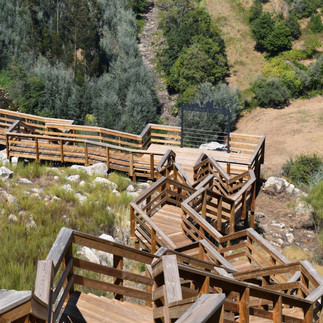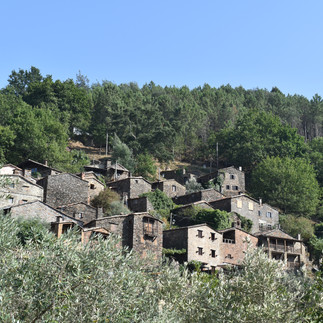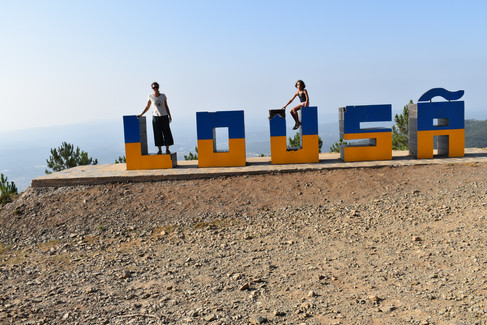Road Trip in Lousã
- Catarina Araújo

- Mar 9, 2023
- 6 min read
Updated: Feb 1, 2024
This post does not intend to be an exhaustive article about schist villages (that is for another time!…) Here we will just describe some of the places we passed during the road trip we did in August 2022. You can read about the first part of our journey in the post The Magic Mountains.
Coming from Serra da Freita, we started to descend towards Lousã, more precisely to the town of Serpins, where we were going to camp. Serpins is approximately 9 km from Lousã and is located on the banks of the Ceira River, which rises in the Serra do Açor and flows into the Mondego River. Our goal was to get to know Praia Fluvial do Desfiladeiro, also known as Praia Fluvial do Cabril do Ceira or Portas do Ceira.

At this location, the Ceira River forms the Ceira River Gorge. The gorge was formed by the fracturing of some harder rocks, the quartzites, by tectonic action. Normally, rivers go around these harder rocks, but here, the Ceira river ended up crossing these rocks, forming a natural pool. The dam built here also contributes to the formation of this pool.
This place is of incredible beauty and a beautiful river beach, where we enjoy a beautiful bath. Access is via a dirt road. If you visit, don't forget to leave the place clean, without garbage!
Next to the natural beach there is an old abandoned railway tunnel, which was part of a project for a railway that would connect Lousã to Arganil. It is known as the Cabril Tunnel.
On the other bank of the Ceira, we go up to Aldeia de Candosa, and to the Sanctuary of Nossa Senhora da Candosa. There, the Cerro da Candosa Walkways were built, which allow for a spectacular view of the Ceira river gorge. The walkways are about 600 meters long (1.2km round trip). After descending the 600m, save your energy for the return, where around 450 steps await you. In summer it is advisable to avoid the hottest hours. Along the walkways there are several viewpoints with scenic views of the surrounding landscape.
Downstairs, we have a beautiful view of the river and Garganta do Ceira. The slope of the cliffs is steep and vertiginous.
After the 2017 fire, the Municipality of Góis took the initiative to build these walkways to reclassify the region and allow visitors to enjoy, in complete safety, this amazing creation of nature that is the Ceira River Gorge.
Serpins Camping Park, where we stayed 2 nights, despite not being as quiet as Retiro da Fraguinha (see previous post), has all the necessary infrastructure and is well located, next to the river and right next to the River Beach of Senhora da Graça. This river beach has surveillance, a swimming pool for children, an extensive lawn and a picnic area.
The next day was dedicated to exploring Serra da Lousã, where we went to visit some river beaches, viewpoints and schist villages.
River Beach of Senhora da Piedade
This is another of the guarded beaches that you can find in this region. There are indeed many river beaches in this region, but we chose this one because it is located in a place known as “Burgo”. There, we can visit the Sanctuary of Nossa Senhora da Piedade and the Castle of Arouce.
The bathing area was built entirely with schist, and also has a café and a restaurant. Between Lousã and the Complexo da Senhora da Piedade, the Walkways of Senhora da Piedade were built, with about 1200m. At night, the walkways are lit up and attract many locals and visitors.
We walk a little along the banks of the Ribeira de São João in search of the Swing of Burgo. Installed over the waters of the stream, it is the perfect place to take pictures, but, unfortunately, the swing had been removed.
We then go up to the Sanctuary of Nossa Senhora da Piedade, which is located on a high hill opposite the Castle of Arouce. Surrounded by a beautiful mountain landscape and schist constructions, we find a set of several chapels, fountains and caves.

Fonte da Esperança (Hope Fountain), all built in schist.
The chapels that make up this set are:
Chapel of São João
Chapel of Agonia
Chapel of Nossa Senhora da Piedade
Chapel of Senhor dos Aflitos
All chapels were built at different times and are in perfect balance with the landscape.
From the Sanctuary, we followed a short pedestrian path that took us to the Waterfall of Senhora da Piedade and to the Fonte Cave.
The path continued connecting with other shale villages, Taslanal and Casal Novo. We'll have to come back another time to walk the Schist Path of Lousã, which recreates the steps of the ancient inhabitants of these mountain villages, when they wanted to go down to the village of Lousã.
Arouce Castle
Visiting Arouce Castle was like traveling back in time and in the stories of the Muslim and Christian conquests that gave rise to Portugal. The castle is classified as a National Monument and is part of the Mondego Castles and Walls Network. In 1604, the Mondego River was the boundary line between the Christian and Muslim worlds. The Mondego Defensive Line was formed with several castles and towers, of which the Castle of Arouce was also part.
After visiting Burgo, we took a van tour to visit the Schist Villages of Candal and Talasnal, as well as some viewpoints.

We stopped to embrace the imposing Sequoia sempervirens, on national road 236.
Candal schist village
This shale village is located on a hill next to the valley crossed by the Candal stream.
As it is located next to the national road, it is one of the shale villages that receives most visitors.

We go up the sloping streets to the Candal Viewpoint, where we can admire a panorama of the village, in the form of an amphitheatre.
The Candal Riverside, which crosses the village, will join the Arouce river, which, in turn, will join the Ceira river. Here in the village, next to the houses, it forms a small natural pool, an ideal place to rest.
At the “Aldeias do Xisto” shop, you can have a coffee, taste the delicacies of the region, such as chestnut "pasteis" and buy locally made handicrafts. In the same building, there is the "Sabores da Aldeia" restaurant, that serves regional dishes, having gained considerable fame among Candal visitors.
In the 20th century, many of the former residents of this village emigrated to the USA and Brazil. They were shepherds, charcoal burners and practiced subsistence agriculture on terraces in the mountains. Some houses near the road were built with emigrants' money and express the new economic status. Instead of the traditional houses built with dark schist, without plaster, these are larger, plastered and with ashlar stone around the windows.
When the Estado Novo ordered the planting of pine trees in the mountains, many residents were employed as planters by the forest services. However, pastoral activity declined due to this massive planting.
Going down the valley next to the stream, we can reach the Candal Waterfall. Despite being on our route, we ended up not going because our daughter was tired and the route is not easy.
We then continued the journey by van. Here, the Serra da Lousã is enchanting. Although there are many pines and eucalyptus trees, there are still species of the old vegetation cover, such as cork oaks, chestnut trees, holm oaks and holly. Silence embraced us as we entered this part of Serra da Lousã.
One of the highlights of this trip was when we saw a red squirrel quickly crossing the road in front of us. In this mountain range, you can easily find deer or hear them during the roaring season.
Talasnal Village
We walked through the alleys and explored the corners of the village of Talasnal. This village never had more than 129 inhabitants. A school was even built, with great effort from the population, but it was later closed due to lack of children.
Desertification was quite severe for Talasnal which, in 1981, had only two permanent inhabitants. Many emigrated to other continents. Nowadays, the houses have been restored and transformed into second homes, accommodation or commercial establishments. There were also two oil mills in the village, one of which was recovered.
Isto é Lousã Viewpoint
And so ended our trip. It was short, but we tried to make the most of it. Here is the promise to come back and further explore the region.
Other points of interest in the region:
Schist village of Cerdeira
Schist village of Casal Novo
Schist village of Chiqueiro
Trevim Swing








































































Comments